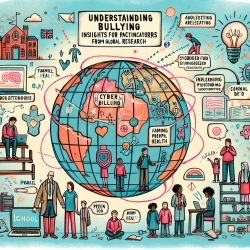Introduction
Bullying victimization among adolescents is a pressing global issue, with significant implications for mental health and well-being. A recent study, "Variation in the prevalence of different forms of bullying victimization among adolescents and their associations with family, peer, and school connectedness," provides a comprehensive overview of bullying across 40 countries, from lower and middle-income to high-income settings. This blog explores the study's findings and discusses how practitioners can leverage these insights to enhance their intervention strategies.
Key Findings
The study highlights several critical findings:
- Traditional bullying is more prevalent than cyberbullying across all countries studied.
- Females are more likely to experience cyberbullying, while males are more prone to traditional bullying.
- Poor family functioning, weak peer relationships, and low school connectedness are strongly associated with all forms of bullying victimization.
Implications for Practitioners
Understanding these dynamics is crucial for practitioners working to mitigate bullying and its effects. Here are some actionable insights:
- Comprehensive Interventions: Programs should address both traditional and cyberbullying, considering their co-occurrence and shared risk factors.
- Family Engagement: Strengthening family functioning through parental involvement and support can significantly reduce bullying victimization.
- Peer and School Environment: Enhancing peer relationships and school connectedness is vital. Schools should foster inclusive environments and promote positive peer interactions.
Encouraging Further Research
While this study provides valuable insights, further research is needed to explore the nuances of bullying across different cultural and economic contexts. Practitioners are encouraged to engage with ongoing research and contribute to the development of tailored interventions that consider local socio-cultural dynamics.
Conclusion
By understanding the prevalence and correlates of bullying, practitioners can design more effective interventions that address the root causes and mitigate the impact on adolescents. This study underscores the importance of a holistic approach, integrating family, peer, and school dynamics to create safer environments for children.
To read the original research paper, please follow this link: Variation in the prevalence of different forms of bullying victimisation among adolescents and their associations with family, peer and school connectedness: a population-based study in 40 lower and middle income to high-income countries (LMIC-HICs).










